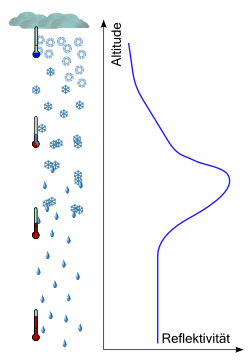Bright band
As Bright band an effect in a precipitation radar referred to as the changed reflectivity occurs during thawing of the precipitate of snowflakes to raindrops. In the Swiss-speaking area, the term Bright Band is translated into German as Helles Band , otherwise the use of the English term is common.
The name comes from the time of single-color analog screens, where a higher reflectivity was indicated by a brighter signal. In a vertical section through the atmosphere, the melting zone then actually appears as a bright band. The software of the weather radar device must correct this effect mathematically.
At very high altitudes, the air temperature is usually below the freezing point of water. Therefore, the precipitation begins with the formation of small ice crystals, which slowly fall towards the surface of the earth. These snowflakes slowly get bigger. The reflectivity increases.
On the way down, the altitude is reached at some point at which the air temperature rises above freezing point. From this moment on, the snowflake's ice will slowly begin to melt. Initially, the ice surface of the snow crystal is covered with a thin layer of melt water. However, water reflects electromagnetic waves almost 10 times better than ice. The snowflake is just as big as before - it will therefore have a very large effective reflection surface. This highly reflective melting snow appears to the precipitation radar as more intense precipitation than it actually is.
As the melting snow continues to fall, it continues to melt until the wet snow becomes pure rain. Raindrops are smaller and also fall faster, so not only the size of the drops, but also their concentration is reduced. The reflectivity has therefore decreased significantly.
Typically the melting zone is about 200 to 500 meters below the zero degree limit. If the precipitation falls to the ground as snow, there can be no bright band.
literature
- JW Ryde: The attenuation and radar echoes produces at centimeter wave lengths by various meteorological phenomena . In: Meteorological Factors in Radio Wave Propagation . Physical Society, London 1946, pp. 169-188.
- Raymond Wexler: An evaluation of the physical effects in the melting layer . MIT Department of Meteorology, Cambridge 1955.
- Soundararajan Raghavan: Radar meteorology (Atmospheric and oceanographic science library; 23). Kluwer Academic Publ., Dordrecht 2005, ISBN 1-402-01604-2 .
